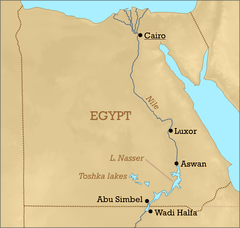Lake Nasser
| Lake Nasser | |
|---|---|
 View from Abu Simbel | |
 Map showing the location of the lake | |
| Coordinates | 22°25′N 31°45′E / 22.417°N 31.750°ECoordinates: 22°25′N 31°45′E / 22.417°N 31.750°E |
| Lake type | Reservoir |
| Primary inflows | Nile |
| Primary outflows | Nile |
| Basin countries | Egypt, Sudan |
| Max. length | 550 km (340 mi) |
| Max. width | 35 km (22 mi) |
| Surface area | 5,250 km2 (2,030 sq mi) |
| Average depth | 25.2 m (83 ft) |
| Max. depth | 180 m (590 ft) |
| Water volume | 132 km3 (32 cu mi)[1] |
| Shore length1 | 7,844 km (25,735,000 ft) |
| Surface elevation | 183 m (600 ft) |
| References | [1] |
| 1 Shore length is not a well-defined measure. | |
Lake Nasser (Arabic: بحيرة ناصر Boħēret Nāṣer, Egyptian Arabic: [boˈħeːɾet ˈnɑːsˤeɾ]) is a vast reservoir in southern Egypt and northern Sudan. It is one of the largest man-made lakes in the world.
Strictly, "Lake Nasser" refers only to the much larger portion of the lake that is in Egyptian territory (83% of the total), with the Sudanese preferring to call their smaller body of water Lake Nubia (Egyptian Arabic: بحيرة نوبية Boħēret Nubeyya, [boˈħeːɾet nʊˈbejjæ]). The area of Sudan-administered Wadi Halfa Salient was largely flooded by Lake Nasser.
Description
The lake is some 550 km (340 mi) long and 35 km (22 mi) across at its widest point, which is near the Tropic of Cancer. It covers a total surface area of 5,250 km2 (2,030 sq mi) and has a storage capacity of some 132 km3 (32 cu mi) of water.
The lake was created as a result of the construction of the Aswan High Dam across the waters of the Nile between 1958 and 1971. The lake is named after Gamal Abdel Nasser, one of the leaders of the Egyptian Revolution of 1952, and the second President of Egypt, who initiated the High Dam project.
Sportfishing among tourists, especially for Nile perch, has become increasingly popular, both on the shore and from boats, as the west bank of the Lake contains more nutrients compared to the east bank. About 100 species of bird have been recorded in the lake.
Although the Abu Simbel temples were physically removed to a different site to spare their destruction by the new lake, other ancient Egyptian sites like the massive fortress of Buhen were flooded and are now at the bottom of the lake.
Panorama

References
- ↑ 1.0 1.1 "Data Summary: Aswan High Dam Reservoir". International Lake Environment Committee. Retrieved March 18, 2012.
External links
| Wikimedia Commons has media related to Lake Nasser. |